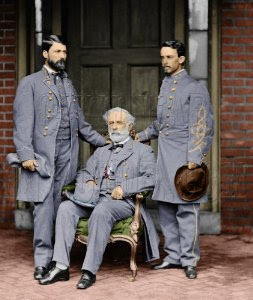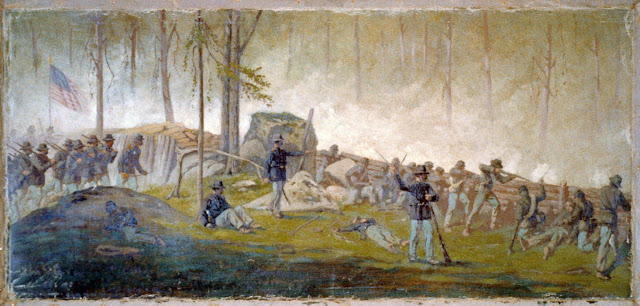I
believe that 47 year old Lieutenant General Richard Stoddert Ewell (above) was the "reigning eccentric" in the army. He was
courageous under fire and generous to a fault, an insomniac and a
hypochondriac. At times his enormous bomb-shaped bald head seemed too
heavy for his neck, and when he was tired it tipped toward one
shoulder or the other. When excited, profanity poured from his 5'8"
frame in a shrill high voice. And he was prone to interrupting
himself with quiet, unrelated interjections, like, "Now why do
you suppose President Davis made me a Major General, anyway?",
and "What would my grandfather think of that?" In
comparison to his other traits, Ewell's pronounced lisp almost seemed
normal.
He had finally married in May, just
before leaving on this campaign, to the woman who nursed him back to
health after losing his left leg at Second Bull Run. His new bride
was his first love and his first cousin, the iron willed and wealthy
widow, Lizinka Campbell Brown.
His personal aide was Lizinka's eldest son, and now "Baldy"
Ewell's stepson, Major Campbell Brown (above). And on this crucial
Wednesday, Major Brown spent most of the day carrying messages
between Ewell and his stepfather's boss, General Robert E. Lee.
Just
after 1:00 p.m. Major Brown had found General Lee atop Herr's Ridge.
He informed Lee of Ewell's arrival on the battlefield, leading
General Rodes' division. According to the Major, Lee was unhappy to
find Archer and Davis' Brigades of Heth's division attacking
McPherson's Ridge. When the rebels were thrown back, General Heth
asked if Rodes division would join the assault. Lee replied, "No,
I am not prepared to bring on a general engagement today. Longstreet
is not (yet) up." Major Brown then added that Lee "asked
me with a peculiar searching...querulous impatience... whether General
Ewell had heard anything of General Stuart...This from a man of Lee's
habitual reserve, surprised me." Added Major Brown, Lee
"impressed upon me, very strongly, that a general engagement was
to be avoided until the rest of the army had arrived."
It took Brown over an hour to find
Ewell again. Old Baldy was now atop Oak Hill and was staring down upon the
Dutchmen of Howard's XI Corps on Oak Ridge. Ewell wrote later, he
felt, "It was too late to
avoid an engagement without abandoning the position already taken
up.” Brown warned his stepfather that Lee was "seething with
anger". But Ewell launched Rodes' 9,000 man division at
the XI Corps. Again the first rebel assault was thrown back, but when
Early's division arrived, and Ewell threw its 5,000 men at Barlow's
Knoll, seeking to outflank Oak Hill.
Finally, Lee (above) was forced to acknowledge
reality and order all units to attack - well, not so much order as
release his commanders to continue their disobedience. Earlier, Lee
had explained his philosophy of command to Captain Justus Scheibert,
a Prussian observer with the army. "I
plan and work with all my might to bring my troops to the right place
at the right time," Lee had said, "(and) with that I have
done my duty. As soon as I order the troops forward into battle, I
lay the fate of my army in the hands of God.” And the divine's
repeat of the Chancellorsville flanking attack encouraged Lee
to accept his subordinate's disobedience.
At
5:00 p.m., as Lieutenant General Ewell was following his troops into
the town of Gettysburg, the positive side of Lee's command
style was on full display. The day had been the 23rd largest battle
of the American Civil War. Lee's 27,000
soldiers in 4 divisions had swept 22,000 Federal troops in 2 corps
off the ridges west and north of Gettysburg. Confederate casualties
numbered about 6,000, while the Federal forces had lost almost 9,000
dead,, wounded and missing. After Gettysburg, neither the I or XI
Union Corps would appear on another battlefield. But after 5:00 p.m.
the reverse side of Lee's command style made itself known.
It
was now that Lee's aide, 25 year old Major Walter Herron Taylor (above), arrived with new orders for General Ewell. As was usual with Lee,
they were verbal. And because they were, exactly what they were
depends on who heard what was said.
Major Taylor (above, right) remembered Lee (above, center) issuing the following orders - "The enemy is retreating over those hills in great confusion.
You only need press those people to secure possession of the heights.
Do this, if possible." Having delivered the order, Taylor
returned to the newly captured Seminary Ridge.
Lieutenant General Ewell, his staff and his Division
commanders, Major Generals Rodes and Early, rode a mile out the Hanover Road to
where it crossed the rise called Benner's Hill, to get a close look
at towering Culps Hill. A mile across the fields they saw troops
moving at the base Culps Hill and assumed they were Federal
infantry.
At
about the same moment, atop Cemetery Hill, General Winfield Scott
Hancock (above) was sitting on a stone wall with General Carl Schurz,
watching the rebels struggling to adsorb their gains and lick their
substantial wounds. Most of the Federal troops on the hill had been
badly mauled, and were exhausted.
But they were still determined to
fight, and with 85 cannon backing his men as they dug in, Hancock
told Shurz he could hold the position until reinforcements arrived.
And in a report dated at 5:25 p.m. Hancock told General Meade, "We
have now taken position in the cemetery and cannot well be taken."
But Hancock was facing west and north. And a mile directly behind
and above him was Culp's Hill.
Standing
atop Benner's Hill, Ewell, Early and Rodes contemplated the
situation. All three saw Federal infantry on Culp's Hill (above).
Behind
them, in the town of Gettysburg, their own units were intermingled
and scattered. Rodes' division had suffered heavy causalities, as had
Early's division - just how many dead and wounded could not be
estimated until the units could be reformed, and a quick head count
made. Many of the soldiers who were able to fight were tied up
guarding the thousands of Federal prisoners just taken.
The only
Division in Ewell's III Corps not yet bled in this fight were the
6,000 men under 47 year old Major
General Edward "Allegheny" Johnson (above). Johnson's
division had not quite reached Carlisle on 29 June, when Lee's orders
to immediately concentrate the army at Chambersburg, arrived. The
logical route was to turn Johnson's men around and march them back
the way they had come - 30 miles south on the Cumberland Valley Pike.
Logically General Rode's division, then at Mechanicsville, returned
via Carlisle where they turned south, expecting to meet General
Early's division at Gettysburg.
Then
Lee shifted the concentration point to Cashtown. The change meant his
army would be protected by the wall of South Mountain. And it also
meant that as he approached from the north General Rodes would turn
off the Carlisle Road and follow secondary roads toward's
Mummitsburg. By luck on the afternoon of 1 July this delivered Rodes
on the flank of Heth's division as it attacked the ridges west of
Gettysburg. But it also meant that Johnson's division, reaching the
Cashtown Gap turn off from the Cumberland Valley Pike, now needed the
same road as Lieutenant General A.P. Hill's supply trains, and
Longstreet's I Corps. Inserting Johnson's men into the columns
delayed both Johnston and Longstreet in reaching Gettysburg.
As
Ewell, Early and Rodes were planning their assault on Culp's Hill, and
awaiting Johnston they were interrupted by the arrival of Lieutenant
Frederick Waugh Smith,
son of 65 year old
Brigadier General William "Extra Billy" Smith (above). Being the
oldest general on the battlefield, and an ex-and the next (governor
elect) Governor of Virginia, "Extra Billy" carried an
authority greater than either his rank or his talents deserved.
Before the campaign, Early had asked General John Gordon to keep a
close eye on the politician turned soldier turned politician. After
entering Gettysburg, Gordon had sent Smith's 800 men 2 miles out the
Hanover Pike as a flank guard. But Smith seemed unable to detach
himself from the drama of the battle.
"Freddy" Smith (above) was the second messenger dispatched from his father. The first had
warned General Early of Federal troops approaching down the Baltimore
Pike.
But now the "overly excited" Freddy announced a large
Federal force was forming up on the Baltimore Pike for an attack
large enough to overwhelm Smith's small brigade along the Hanover Pike. Nobody on Benner's
Hill except "Freddy Smith" believed there was a large
Federal force on the Baltimore Pike. But General Early told his
boss, "I don’t much believe in this, but prefer to suspend my
movements until I can send and inquire into it.’ When Ewell agreed,
Early sent a second brigade to reinforce Smith, and get him under
control.
That
left Ewell with only Rodes' exhausted division to work with - not
enough to take Culp's Hill against Federal infantry. So "Baldy"
Ewell dispatched Captain James Powers Smith (above) - no relation to the
governor - to General Lee, asking for reinforcements from A.P. Hill's
Corps to make the assault. While
waiting for the reply, Major
General Johnson's division came in from their second 25 mile march in
2 days.
It
was after 6:00 p.m. before Johnson's men finally stumbled into
positions facing Cemetery Hill. Ewell issued Johnson the same orders
Lee had given him. Johnson was to assault Cemetery Hill if he thought
it possible. Johnson took a look at his weary men and a look 70 feet up the slope at the
rows of Federal artillery staring down at him and decided it was not
possible.
Just
about the moment that Johnson was reaching his decision, Captain
Smith returned from General Lee. with bad news. A.P. Hill had no
fresh troops available, in large part because Johnson's march had
delayed the rest of A.P. Hill's Corps. There would be no
reinforcements for an assault on Culp's Hill. But, added Lee, Ewell
should go ahead with the attack "if practicable.” Again there
were no written orders, and again the verbal ones carried a modifying
phrase which weakened them. But Lee then went further, repeating
his original written order, without a modifying phrase. Ewell was not
to bring on a general engagement until the rest of the army - meaning
Longstreet's Corps - had arrived.
With
Early's division chasing shadows in the deepening dusk, and now out
of position to attack Culp's Hill, Ewell decided to let his
victorious men rest. Tomorrow there would be time to clear the
Federals off Cemetery Hill and ridge. Except...
The
infantry Ewell, Early and Rodes had seen at 5:30 p.m. were a
Massachusetts brigade under General Thomas Ruger (above) from the Federal XII Corps, just arriving at Gettysburg..
And shortly thereafter Ruger received
orders to withdraw for the night and encamp along the Baltimore Pike.
These were the men "Extra Billy" Smith had seen gathering
in the distance. But by 6:30 p.m., when Early's assault would have
been launched, there were no Federal troops on the high ground
overlooking Cemetery Hill and Ridge.
- 30 -



























































No comments:
Post a Comment
Please share your reaction.